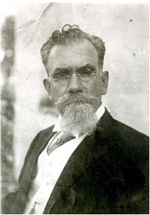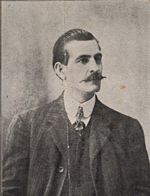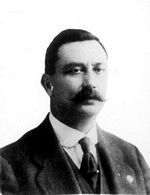Gobierno Provisional de México notes
On 19 September 1914 in Mexico City Venustiano Carranza decreed the creation of an Interior Debt of $130m, by means of the issue of paper currency, in six values ($1, $5, $10, $20, $50 and $100) and six Series (A-F respectively). These were the “Gobierno Provisional de México” notes of 28 September and 20 October 1914. During the first days of December 1914, due to pressure from the Conventionist government, Carranza decided to move the capital of the Constitutionalist government to Veracruz.
The $100 notes of 28 September and some $50 notes of 20 October had the printed signatures of Nicéforo Zambrano as Tesorero General and Carlos M. Esquerro as Oficial Mayor Encargado de la Secretaría de Hacienda while the other 20 October notes had Zambrano and José J. Reynoso as Subsecretario Encargado de la Secretaría de Hacienda.
The notes began to circulate on 19 October, with the salaries of some government employees paid in the new notesThe Mexican Herald, 20 October 1914.
In late November the Tesorería opened an office in the National Palace to exchange the various revolutionary issues of Durango, Sinaloa, Tamaulipas and Chihuahua and the Carbajal bonos for notes of the new issue. The amount of notes exchanged on 17 November reached $70,000The Mexican Herald, 19 November 1914.
On 17 December 1914, Eulalio Gutiérrez, the provisional president, issued a decree stating that, as the Carrancistas, when evacuating the capital, has taken the plates (placas y piedras) for the Gobierno Provisional issue and intended to continue issuing notes, and it would be unjust for the National Treasury to take on such an obligation, he was declaring null and void any notes that were not included in his list. Holders were given ten days (or twenty outside the capital) to exchange their notes. In the Distrito Federal the exchange would be made in the offices of the Secretaría de Hacienda for note of the same issue, already revalidated. Elsewhere the exchange would be made by the Jefaturas de Hacienda y Administraciones principales and subalternas de la Renta del Timbre. The offices would give the holders a receipt (constancia), remit their notes to the Tesorería de la Federación for exchange and revalidation, and then give out the revalidated notes in exchange for the receipt.
The numbers listed were:
| Series | from | to | Total | Value | |
| $1 | A | 1 | 999999 | 999,999 | $ 1,000,000 |
| A (1 a) | 1 | 637500 | 637,500 | 637,500 | |
| $5 | B | 1 | 999999 | 1,000,000 | 5,000,000 |
| B (1 a) | 1 | 198000 | 198,000 | 990,000 | |
| $50 | E | 1 | 200000 | 200,000 | 10,000,000 |
| $100 | F | 1 | 450000 | 450,000 | 45,000,000 |
| $62,627,500 |
Any notes with higher numbers were declared null and void.
An important notice, of the same day, explained that the notes would be revalidated on the face with an overprint designated for the Tesorería de la Federacion, in the capital, and for the Jefaturas de Hacienda and Administraciones Principales and Subalternas de la Renta del Timbre, elsewhereThe Mexican Herald, 20th Year, No. 7046, 22 December 1914; El Correo Español, Año XXVI, Núm. 7317, 22 December 1914;.La Opinión, Año I, Tomo I, Núm. 17, 22 December 1914; El Sol, Núm. 135, 22 December 1914; El Monitor, Mexico Tomo I, Núm. 18, 22 December 1914.
However, the decree had an error which was corrected on 22 December when the numbers were relisted as
| Series | from | to | Total | Value | |
| $1 | A | 1 | 999999 | 999,999 | $ 1,000,000 |
| A (1 a) | 1 | 637500 | 637,500 | 637,500 | |
| $5 | B | 1 | 1198000 | 1,198,000 | 5,990,000 |
| $50 | E | 1 | 200000 | 200,000 | 10,000,000 |
| $100 | F | 1 | 450000 | 450,000 | 45,000,000 |
| $62,627,500 |
According to the Secretaría de Hacienda, at first the numbering machine only had six digits, so it was necessary to number the $1 notes above 1000000 as (1 a). By the time they printed the $5 notes they had adquired a machine with seven digitsLa Opinión, Año I, Tomo I, Núm. 18, 23 December 1914; El Monitor, Mexico City, Tomo I, Núm. 19, 23 December 1914; La Convención, Tomo I, Núm. 20, 23 December 1914. This was reproduced in various provincial notices, e.g. Periódico Oficial, Aguascalientes, Tomo I, Num. 2, 28 December 1914.
In Guadalajara, on 31 December, governor Julián C. Medina, told the press that the Tesorería de la Federación, had informed the Jefatura de Hacienda that the deadline for revalidation had been extended until 25 JanuaryLa República, Núm. 1, 6 January 1915. La República reproduced the first, erroneous decree. In Zacatecas, on 14 January 1915, the governor told Teodoro Carrillo, the Jefe de Hacienda, to begin exchanging the notes. For sums greater the $100 the exchange would be made in the Jefatura de Hacienda, for smaller sums in the Administración del TimbreSiglo XX, Zacatecas, Núm. 52, 14 January 1915.
However, when Eulalio Gutiérrez took over, his government managed to use some plates and tools that had been left behind and, by mistake or design, had been inadequately disabled and could be repaired. In addition the Conventionist government ordered the printing of Gobierno Provisional de México issues at Yecapixtla, MorelosThese notes are $5, $10 and $20. The tell-tale sign of a Yecapixtla note is its low to disastrously low printing, centering and engraving quality. All Yecapixtla notes have their Secretaría seals printed by the flat lithography or book press process. While many of the notes are on thin paper the notes were printed on thin paper sandwiched in between thick paper so appear in a variety of thickness. So both factions continued to print notes, and this explains why the Conventionists changed the number range of the notes they acknowledged as legitimate.
On 23 January the new provisional president, Roque González Garza amended the decree, so that the legitimate numbers were now
| Series | from | to | Total | Value | |
| $1 | A | 1 | 6000000 | 6,000,000 | $ 6,000,000 |
| A (1 a) | 1 | 677500obviously a simple error | 677,500 | 677,500 | |
| $5 | B | 1 | 2198000 | 2,198,000 | 10,990,000 |
| $50 | E | 1 | 200000 | 200,000 | 10,000,000 |
| $100 | F | 1 | 550000 | 550,000 | 55,000,000 |
| $82,667,500 |
and extended the period for revalidation until 15 MarchEl Monitor, Mexico Tomo II, Núm. 51, 24 January 1915; Gazeta del Gobierno, Toluca, Tomo XXXVII, Núm. 10, 3 February 1915{.
On 26 January General Otilio E. Montaño and Alejandro R. Acevés were authorised by the Convention to collect from the Tesorería de la Federación the money it held and the plates used to print notes (clichés para imprimir billetes que hay en dicha oficina)AGN, Fondo Convención, caja 3, exp. 2.
On 31 May Roque González Garza, again amended the list. Now it was
| Series | from | to | Total | Value | |
| $1 | A | 1 | 6000000 | 6,000,000 | $ 6,000,000 |
| A (1 a) | 1 | 637500 | 637,500 | 637,500 | |
| $5 | B | 1 | 3198000 | 3,198,000 | 15,990,000 |
| $50 | E | 1 | 400000 | 400,000 | 20,000,000 |
| $100 | F | 1 | 700000 | 700,000 | 70,000,000 |
| $112,627,500 |
The reason given for the change was that the new notes had been issued to replace the Monclova and Villista issues which were too easily counterfeitedLa Convención, 5 June 1915. This new decree was not reported in the Mexico City newspapers until 6 July, amid rumours that the revalidated notes were not valid, except within certain rangesThe Mexican Herald, 6 July 1915; El Renovador, Tomo I, Núm. 21, 6 July 1915.
On 1 July 1915 Ministro de Hacienda y Crédito Público Luis Zubiría y Campa reportedThe Mexican Herald, Año XX, No. 7236, 1 July 1915 figures corrected as they did not total that they had issued:
| Series | from | to | Total | Value | |
| $1 | 3,285,000 | $ 3,285,000 | |||
| $5 | 2,708,500 | 13,542,500 | |||
| $50 | 200,000 | 10,000,000 | |||
| $100 | 668,000 | 66,800,000 | |||
| $93,627,500 |
However, in preparation for retaking Mexico City, the Carrancistas turned their attention to the issues of the Gobierno Provisional notes from Mexico City and the ones they had themselves made in Veracruz. On 12 May Anastasio Rojas, the contador at the Oficina Impresora de Billetes in Veracruz has produced a report on the Mexico and Veracruz issuesCEHM, Fondo-XXI, carpeta 39, legajo 4265. Based on this, on 9 July, in Veracruz, the Carrancista Secretaría de Hacienda issued its circular núm. 31 stating that the following Mexico notes were valid
| Series | from | to | Total | Value | |
| $5 | B | 1 | 1198000 | 1,198,000 | $ 5,990,000 |
| $50 | E | 1 | 200000 | 200,000 | 10,000,000 |
| $100 | F | 1 | 250000 | 250,000 | 25,000,000 |
| $40,990,000 |
and that all higher numbers were null and void. This information was sent to the various states, such as QuerétaroAQ, Fondo Poder Ejecutivo Sec 2ª Hacienda C-3 Año 1915 Exp. 239 telegram núm. 650, Nieto, Veracruz to governor, Querétaro .9 July 1915 and AQ, Fondo Poder Ejecutivo Sec 2ª Hacienda C-3 Año 1915 Exp. 239, Nuevo León ANL, Fondo Leyes, Decretos y Circulares, Colecciones de Circulares, Año 1915-1919, caja 7 telegram núm 625, 9 July 1915 and Baja California ABCS, Gobernación, vol. 642, exp. 150 and subsequently published, such as in circular núm. 7 from the government in Monterrey, Nuevo León ANL, Fondo Leyes, Decretos y Circulares, Colecciones de Circulares, Año 1915-1919, caja 7 circular núm 7, 15 July 1915. Obviously, the Secretaria had overlooked the $1 notes, and these were added in circular núm. 33 of 16 July.
| Series | from | to | Total | Value | |
| $1 | A | 1 | 1635000 | 1,635,000 | $1,635,000 |
| $1,635,000 |
On 10 July 1915 Luis Cabrera wrote to Pablo González, in Tepexpan that, in view of the forthcoming occupation of Mexico City, he had to thank him for stating that the Oficina Impresora de Billetes, which had been managed by the Zapatistas and was using some Gobierno Provisional de México plates, should be closed immediately the troops arrived, to carry out a full inventory and ensure nothing was removedCEHM, Fondo XXI-4, Luis Cabrera, Veracruz to Pablo González, Tepexpan, 10 July 1915.
On 20 July the Cámara de Comercio in Veracruz wrote to the Secretaría de Hacienda stating that its members held sizeable quantities of the ‘Conventionist’ Gobierno Provisional de México notes that had just been declared worthless and asking for them to be exchanged, with their reasons being
(a) that commerce and the public were not responsible for the fact that some clichés had remained in Mexico City and could have been used by fraudsters;
(b) that the government stopped publishing the numbering of the banknotes it had issued when it left Mexico City; and, finally,
(c) that the public offices accepted these notes until the date they were declared void.
On 14 August Rafael Nieto responded, denying their request, refuting their arguments and refusing to make an exception to Carranza’s orderEl Dictamen, Tomo XVII, Núm. 1588, 19 August 1915.
On 28 July Carranza issued a decree that, as the intention was to unify the currency and withdraw earlier issues, from 1 August the following would be withdrawn from circulation, thus confirming the previous acknowledgements
| Series | from | to | Total | Value | |
| $1 | A | 1 | 1635000 | 1,635,000 | $ 1,635,000 |
| $5 | B | 1 | 1198000 | 1,198,000 | 5,990,000 |
| $50 | E | 1 | 200000 | 200,000 | 10,000,000 |
| $100 | F | 1 | 250000 | 250,000 | 25,000,000 |
| $42,625,000 |
These would be exchanged in the Tesorería General de la Nación and in the Jefaturas de Hacienda and designated oficinas del Timbre for others of legal circulation during August. If these notes had been revalidated they were referred to as ‘low revalidateds’ (revalidados bajos) to contrast them with any revalidated note that carried a higher serial number – the ‘high revalidateds’ (revalidados altos). Carranza also ordered an issue of $42,625,000 to replace the withdrawn notes. The $42,625,000 were recognized by Carranza whether or not they had been revalidated.
On 6 August the Carrancista Subsecretary Rafael Nieto explained his understanding of the history of the Gobierno Provisional issueThe Mexican Herald, 6 August 1915. According to Nieto, up to the time that Obregón reentered the city in February the Convention produced, between 10 December 1914 and 15 January 1915,
| Series | from | to | Total | Value | |
| $100 | F | 250001 | 450000 | 200,000 | $20,000,000 |
| $20,000,000 |
but Nieto added that the Conventionists had gone on to produce
| Series | from | to | Total | Value | |
| $1 | A | 1635001 | 3285000 | 1,650,000 | $ 1,650,000 |
| $5 | B | 1198001 | 3542500Nieto reported that the Conventionists had issued $12,344,500 in $5 notes, up to serial number 3542500. Either the number or total must be wrong | 2,468,900 | 12,344,500 |
| $100 | F | 450000 | 680000 | 230,000 | 23,000,000 |
| $36,994,500 |
These extra notes did not circulate in the territory dominated by the Carrancistas until when some were introduced into Puebla (though the diplomatic service of foreign countries) and into Veracruz, brought on a train of foreign refugees.
On 12 August Federico Montes, governor of Querétaro, declared that the early notes (and those issued in Veracruz) were of forced circulation, but the later Zapatista issues were null and voidAQ, Fondo Poder Ejecutivo Sec 2ª Hacienda C-3 Año 1915 Exp. 239. Likewise, a week later, on 19 August, José Siurob, governor of Guanajuato, made a similar declarationASalvatierra, Municipal, caja 1915.

 Nicéforo Zambrano was born in Monterrey, Nuevo León, in 1862. He joined the revolution during Madero’s campaign and at its triumph had been elected president of the Monterrey town council. He was imprisoned during Huerta’s regime but on release supported Carranza, both against Huerta and then against Villa.
Nicéforo Zambrano was born in Monterrey, Nuevo León, in 1862. He joined the revolution during Madero’s campaign and at its triumph had been elected president of the Monterrey town council. He was imprisoned during Huerta’s regime but on release supported Carranza, both against Huerta and then against Villa.
 Carlos M. Esquerro was born in Concordia, Sinaloa in 1866. In his youth he opposed the local caciques and was an early supporter of Madero, being elected to the XXVI Legislature, which was known as the Maderista Legislature and was dissolved by Huerta.
Carlos M. Esquerro was born in Concordia, Sinaloa in 1866. In his youth he opposed the local caciques and was an early supporter of Madero, being elected to the XXVI Legislature, which was known as the Maderista Legislature and was dissolved by Huerta.

